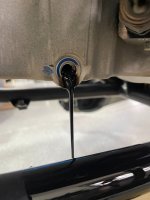Reece Pettersen
Well-known member
- May 6, 2021
- 234
- 263
Follow along with the video below to see how to install our site as a web app on your home screen.
Note: This feature may not be available in some browsers.
1) probably ~7.5k off road milesReece,
The sample shows 500 miles on this oil. Questions I have.
1. Actual miles to the best guess.
2. Oil brand and weight. Never mind. I see Mobil 1 5w-30
3. Gasoline, race gas or E85.
4. Do you get the majority of the oil out with each oil change or is there oil left behind in an oil cooler, oil lines, oil pan etc.
5. The most important with oil samples is trending wear. A one off oil sample doesn't help with determining how bad this could be. Its used all the time for pre purchase evaluations but comes with more questions when they come back like this.
There is usually some carry over in wear metals from the break in and build up in the oil pan can cause a false alarm. Taking the oil sample from the drain plug isn't the ideal way. Proper oil sampling is from a scavenger hand pump, new nylon tube and taken from warmed up oil with the tube inserted into a dipstick tube from the oil at the half level area. You want to take the sample with minerals in suspension and not from the oil pan bottom.
I am happy to comment on the results and where these minerals come from but if the sample is compromised by the technique taken to pull them then this may be all for nothing.
BTW, I process and interpret 1000's of samples a year.
One a new or rebuilt engine I would wait 500 miles or 100 hours. This lets the rings seat and the cylinders wear in. Then I would oil sample at 500 miles. This is on a basic run of the mill naturally aspirated engine. Outside of that its the wild west. Most engine builders are asking owners to change oil after a healthy week in the dunes on Turbo and supercharged race gas and E85 fueled engines. Personally I sample at 500 miles on a Turbo E85 subi.@Grease Monkey How many hours of use for a sandcar would you suggest for test intervals for a n/a unleaded engine?

The oil is doing its job. Mobil 1 has shown to be a good oil. This isnt a highway cruiser.@Grease Monkey this is some really good information. Thank you! Makes me think I should keep running the engine since I might have elevated readings due to sampling from the drain plug.
I have been struggling with dirty oil after minimal off road miles and still can't figure it out. I run dual UMP filters and the intake/throttle body is always clean with no signs of passing dust when I change the oil. However, the oil looks like it is very contaminated and dirty. Thought it might be a leak in the intake manifold, but that would cause high idle and show up on the dyno.
View attachment 109513
CBM recommends changing oil in boosted motors after every dune trip.One a new or rebuilt engine I would wait 500 miles or 100 hours. This lets the rings seat and the cylinders wear in. Then I would oil sample at 500 miles. This is on a basic run of the mill naturally aspirated engine. Outside of that its the wild west. Most engine builders are asking owners to change oil after a healthy week in the dunes on Turbo and supercharged race gas and E85 fueled engines. Personally I sample at 500 miles on a Turbo E85 subi.
Same here. Boosted and on E85, change every trip. Cheap insurance.CBM recommends changing oil in boosted motors after every dune trip.
I change mine every other dune trip and clean air filters every trip.
No oil analysis to back anything up, just what I've always done.
Mid stream sampling is fine. Different labs give slightly different sampling procedures. The lab I use tells me to not start the engine immediately prior to taking the sample.I have always sampled at the drain plug, but wipe/blow with compressed air around the plug before removal, and then sample "mid-stream". Is this incorrect?
I have always sampled at the drain plug, but wipe/blow with compressed air around the plug before removal, and then sample "mid-stream". Is this incorrect?
Bottom sediment, debris and particles (including water) enter the bottle in concentrations that are not representative of what is experienced near or around the area where the oil lubricates the machine components.Mid stream sampling is fine. Different labs give slightly different sampling procedures. The lab I use tells me to not start the engine immediately prior to taking the sample.
One would think that sampling through the dipstick tube at mid pan oil level is the most accurate. The lab I use feels that both sampling methods are suitable with little to no difference in test results between the two. Maybe I need to change labs :classic_biggrin:Bottom sediment, debris and particles (including water) enter the bottle in concentrations that are not representative of what is experienced near or around the area where the oil lubricates the machine components.
Not ideal but if you are using these samples to trend wear and you can repeat the process every time with the same hours/miles, this can be used to trend wear. Unfortunately as in Reece's case, this may lead to a false positive for elevated wear minerals/materials.
The best sample method is from a ported fitting pre filter from the running machinery. This would sample the oil at operating temp and from fluid that is lubricating the machinery. One thing to focus on is AT operating temp.One would think that sampling through the dipstick tube at mid pan oil level is the most accurate. The lab I use feels that both sampling methods are suitable with little to no difference in test results between the two. Maybe I need to change labs :classic_biggrin:
I know it would double the cost, but.... maybe do both 3 or 4 times and review the results. It could be beneficial for the rest of us. LOLOne would think that sampling through the dipstick tube at mid pan oil level is the most accurate. The lab I use feels that both sampling methods are suitable with little to no difference in test results between the two. Maybe I need to change labs :classic_biggrin:

